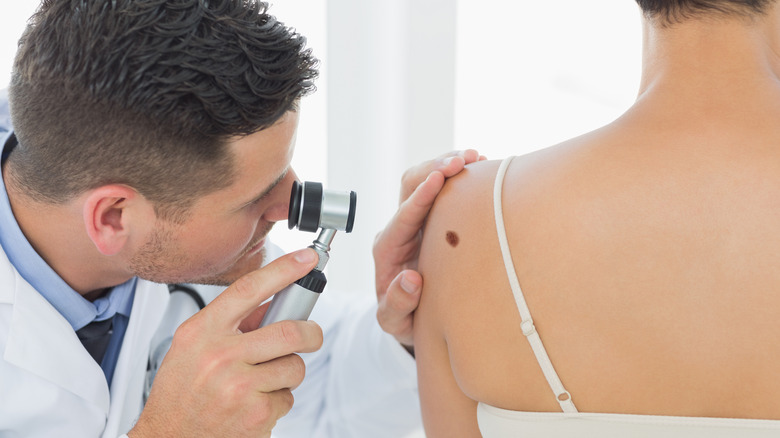Do This With Your Body At Least Once A Month To Prevent Cancer
Even if you don't like going to the doctor, certain health screenings each year are critical to preventing disease. People in their 20s and 30s should get screened for blood pressure, depression, and body mass index. Women in their 40s need to get mammograms each year, and men in their 50s should get their cholesterol checked each year (per University Hospitals). Regardless of your age, you also need to get a skin cancer screening every year.
Skin cancer is rather common, affecting one out of every five people in the United States before the age of 70. Not all skin cancer is the deadly melanoma. In fact, nonmelanoma skin cancers like basal cell carcinoma and squamous cell carcinoma are much more common, according to the Skin Cancer Foundation.
Even if you get your skin checked once a year, doctors might recommend checking your skin each month, according to the American Cancer Society. This might be particularly the case if you have a weak immune system or a history of skin cancer in your family or yourself.
Types of skin cancer
Basal cell carcinoma is a type of skin cancer that can look like a red or pale lump or a scaly part of the skin. They could look like an ulcer on the skin that doesn't heal. Basal cell carcinoma grows slowly on the skin and is the least dangerous. People over 50 are more likely to have squamous cell carcinomas. Like basal cell carcinoma, squamous cells also grow slowly and can be red and scaly.
Unlike other types of skin cancer, melanoma can develop on areas of your skin that don't see the sun. Melanoma might appear as a new spot on your skin, or could develop on an existing spot or mole. It will change shape, color, or size. Nodular melanomas are different from common melanomas, appearing red, pink, brown, or black. These will grow quickly on your skin. Although they're firm, nodular melanomas might bleed over time.
When looking at your skin, use the ABCDE formula. Any mole that is asymmetrical with an irregular border and different colors could point to melanoma. Show your doctor any moles that are larger than a pencil eraser and evolve over time. Moles that bleed, weep, itch, or tingle should also be looked at by your doctor (per Cancer Council).
How to do a monthly self-check for skin cancer
The American Cancer Society suggests checking for any freckles, moles, or anything else on your skin. Notice the different pigments in your skin and any skin-colored bumps or blemishes. You'll get used to these different markings on your skin as you make a habit of checking yourself. While you might not notice changes in a single day, you might see subtle shifts once a month.
A skin cancer self-check is best done after you take a bath or shower. You'll need a mirror to help you look at places that are difficult to access. You'll also need a wall-mounted mirror in your bathroom or vanity. Start by facing the mirror and looking closely at your face, shoulders, chest, and belly. Women also need to check under their breasts.
Then move to your arms, beginning with your underarms. Although you might look at your hands often, be sure to check under your fingernails and between your fingers.
Sitting down can help you check your legs, and be sure to look closely at your toenails and between your toes. Use your hand mirror to look for any marks or freckles under your feet. Your hand mirror will also help you look at the back of your thighs.
Use both the hand mirror and the wall mirror to scan the marks on your back, buttocks, and genital area. You might need a comb to look at any moles on your scalp. Don't forget your ears and neck!



